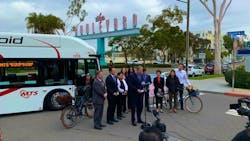San Diego, Calif., opened a three-mile stretch of bus-only lanes along El Cajon Boulevard on Jan. 8, marking the completion of the Boulevard Bus Way. San Diego Mayor Kevin L. Faulconer says the project aims to improve regional transit while reducing pollution.
“San Diego is on a journey to create a cleaner future for folks now and in the future, and the Boulevard Bus Way is the latest example,” said Mayor Faulconer. “We’re slashing greenhouse gas emissions with transportation improvements, increasing mobility options and installing hundreds of miles of new bike lanes. This type of low cost, high-impact infrastructure is how we encourage people to get out of their cars and try public transit.”
The Boulevard Bus Way is a pilot project spearheaded by the city of San Diego, the Metropolitan Transit System (MTS) and El Cajon Boulevard Business Improvement Association. The section of El Cajon between Park Boulevard and Fairmont Avenue serves more than 10,000 passengers daily on three MTS routes including Rapid 215, Route 1 and Route 6 and connects some of the city’s oldest urban neighborhoods.
Over the next 18 months, MTS will evaluate the project for operational benefits, including travel time reliability, visibility and overall ridership. The city will then use this data to determine if a more permanent fixture makes sense for the communities it serves.
“The Boulevard Bus Way is a forward-thinking, faster-moving approach to mobility. It is a great example of how the region needs to think differently about mobility,” said Nathan Fletcher, MTS Board chair and San Diego County supervisor. “It will help create better transit options for local communities, attract new riders and build on the great success of the Rapid bus network we’ve been building.”
To promote the Boulevard Bus Way, MTS and the San Diego Association of Governments (SANDAG) are offering free rides on the Rapid 215 through Jan. 17, MTS hosted a customer appreciation event on Jan. 9 and local businesses along El Cajon Boulevard are offering promotions for bus riders who show their Compass Card or Compass Cloud App.
“The success of the Boulevard Bus Way in San Diego will pave the way for future bus routes to follow suit, improving reliability and providing riders with frequent and efficient service,” said SANDAG Vice-Chair and Encinitas Mayor Catherine Blakespear. “As the regional transportation planning agency, SANDAG is committed to working with our partners to find innovative solutions in the fight to reduce greenhouse gas emissions. We invite everyone to get out of their cars and try Rapid 215 for free this week.”
The Boulevard Bus Way project is one initiative aimed at supporting San Diego’s Climate Action Plan, which calls for the elimination of half of all greenhouse gas emissions and the use of 100 percent renewable energy citywide by 2035.
As part of the ceremony to open the Boulevard Bus Way, the Climate Action Campaign and the BQuest Foundation announced more than 50 shade trees would be donated and planted on El Cajon Boulevard between Interstate 15 and Highland Avenue. The trees were selected from the city’s preferred list of tree species recommended for streetscaping, low water use and canopy potential. Stakeholders believe by increasing shade and reducing heat, more trees will improve pedestrian activity, cut down on car travel and encourage foot traffic for local businesses.

Mischa Wanek-Libman | Group Editorial Director
Mischa Wanek-Libman is director of communications with Transdev North America. She has more than 20 years of experience working in the transportation industry covering construction projects, engineering challenges, transit and rail operations and best practices.
Wanek-Libman has held top editorial positions at freight rail and public transportation business-to-business publications including as editor-in-chief and editorial director of Mass Transit from 2018-2024. She has been recognized for editorial excellence through her individual work, as well as for collaborative content.
She is an active member of the American Public Transportation Association's Marketing and Communications Committee and served 14 years as a Board Observer on the National Railroad Construction and Maintenance Association (NRC) Board of Directors.
She is a graduate of Drake University in Des Moines, Iowa, where she earned a Bachelor of Arts degree in Journalism and Mass Communication.



